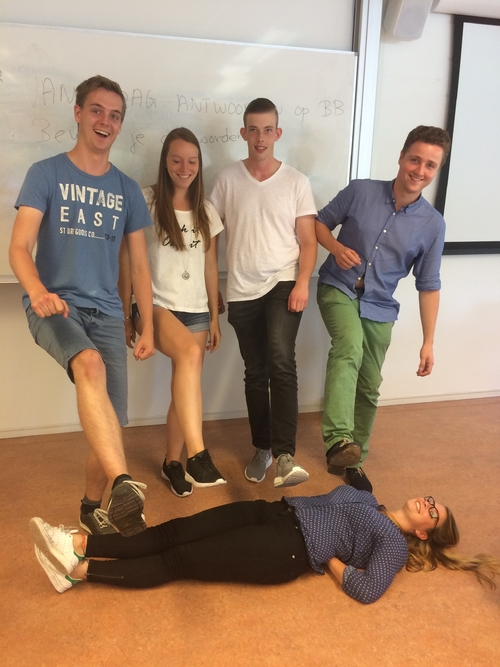
In the first part of the class we split the students up in groups of 5 or 6. They were asked three questions in the following format: the groups were asked one question, then had about twenty minutes to think about it before they were asked the next question. We started of the session with the question: "What is the world we live in?" With this we tried to encourage them to think about what we see happening in the world around us (regarding RI). Secondly we asked them which changes they see in this world and whether they like those or not. With this in mind we asked them to think about responsibility and more specifically what their responsibility is. With the answers they gave on these previous questions we asked them the key question: "What is Responsible Innovation?"
After having formulated their definition as a group we asked them to present what they thought Responsible Innovation was and how they came up with it. It was very interesting to see that even though every group was pushed down the same road of questions, they came up with very different answers.
The first group for example defined responsible innovation as the awareness of the consequences of innovation on all the stakeholders in the process. You could also see this as social innovation. It is very dependent on the technology. People live in chaos and innovation can either solve or worsen their problems. As such with great power comes great responsibility.
According to the second group RI is making 'technical' innovations with a collective values system. Technology has set us free and given us the opportunity to express ourselves. This was first done collectively during the 50's and 60's, but this has shifted to a much more individual approach. This also means that responsibility has shifted from the collective to the individual.
The opinion of the third group is similar though not equal to the first two. They very clearly state that RI is any change that improves the picture regarding social, economic and ecological aspects. A purely technical innovation is not responsible innovation. They see a very quickly changing world that is growing into it's full potential very quickly. However nature is becoming artificial almost everywhere and differences between rich and poor are becoming ever bigger. They also say something very interesting about the fact that we have to stitch our own wounds. In other words we've caused great problems we also have to fix ourselves, seeing as no one is going to do that for us.
The fourth group proposes that RI has to be harmless to mankind and to be reached by consensus with the neighborhood to make all aspects visible and have solidarity within the community. They agree that there are multiple definitions of responsibility and therefore also many aspects of responsibility.
The last group states that RI involves being aware of our mindset and the effects on the environment around you. They see RI as the use of increasing knowledge and resources in order to guarantee the well-being of the environment and mankind. They see the world as a dynamic environment in which humans constantly have to innovate to prevent the decay of our habitat. However they don't see technology just as a way to improve, but also as a barrier. Technology can dehumanize or create ethical issues. We as individuals have to take responsibility to make sure technology is used in a positive way.
We personally think there is a lot of truth in all of these definitions. We think responsible innovation doesn't necessarily include technical innovation, but really comes down to facing social, economic and environmental challenges. Any new solution to an existing problem can be seen as an innovation. Responsible Innovation therefore really boils down to improving the well-being of the environment and the people.
In the second part of the lecture we focused on ways of improving the mindset of our fellow students with regard to responsible innovation by giving multiple examples.
We first explained the trolley problem to the group. In order to explain this concept we put five persons in a row in front of the class. Besides that, we also put one person in front of the room next to the row. Next we asked for a volunteer and we asked this person a question. We explained that there was a train coming and that it was driving towards the five people. Then we told him that he had the lever in his hand. With this lever he was able to change the track of the train, so the train would drive over the track where only one person was standing. We asked him what he would do, would he pull the lever? He said he would do this and the rest of the class agreed with him almost immediately. Following this we changed the story a bit. We put two people on a chair, and told them there was a fictive bridge over the track where the five people were standing on. In this case we told the person that when she pushed the guy from the fictive bridge she would stop the train and save the lives of the five people standing in a row but kill the person she pushes from the bridge. In this case it was clear that it was a lot harder to make a decision. Nobody was able to really say they would push the guy from the bridge. As we explained to them, this was exactly the point of the trolley problem.
As the second exercise we let all the groups think about a real-life example of the trolley problem. Afterwards we discussed with the class the result of every group. Every group came up with an example like the one of a self-driving car. When a self-driving car is developed, someone needs to take the responsibility to take moral decisions like the trolley dilemma.
Next a presentation was given by one of us on three perspectives for ascribing responsibility (Doorn, 2012). The presentation did not go as well as planned, because the matter was pretty hard to understand. At the end of the presentation it was a bit hard for fellow students to understand what the presentation was about. Gladly Caroline explained the matter a bit more and a discussion between the students started. Hopefully we managed to give our fellow students a better understanding of the three perspectives for ascribing responsibility.
After the interactive lecture about the trolley problem, it was time to explain something about individual and collective responsibility. As preparation we watched all the videos and read the article, Caroline gave us an idea to make the lecture really interactive. There where a couple of examples given in the videos so we thought that we could use those. Our idea of interactive was the well-known quiz of ‘petje op petje af’, because the people in class will not have a cap it thought of the idea ‘mobile on your head mobile off your head’. First we let them stand up in front of their chairs. After that the game with the questions begun, if they had an answer wrong they would have to sit down. Several questions about causally responsibility, morally responsibility and praiseworthiness/blameworthiness were asked. All the questions can be found in the attachment file. The idea was that we would focus on the part of the individual responsibility because Jasper would tell them all about the Tragedy of the Commons.
The last small lecture during this second part was about a collective action problem, also known as the tragedy of the commons. We explained how it worked and gave an example of fishermen over-exploiting the fish, this problem took a bit longer to explain but we think this was necessary for everyone to understand. This was at the end of the class, so everyone was a bit drowsy, but most of the class really listened very well and we were told this was a relative good lecture. In our minds we could've done a bit better, sadly this was a combination of factors. One of them was a lack of time, but we understand time management is difficult in a new interdisciplinary minor.
Bibliography
Doorn, N. (2012, March). Responsibility Ascriptions in Technology Development and Engineering: Three Perspectives. Science and Engineering Ethics, pp. 69-90.

